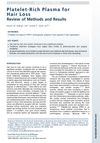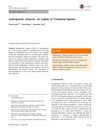How true is the statement: dead follicles don't grow back? Research/Science 3/6/2025
Hair follicles usually go dormant rather than die, and treatments like finasteride, minoxidil, and hormone therapy can sometimes reactivate them, though results vary. Complete regrowth is rare, especially in long-term bald areas, but some individuals see significant improvement with these treatments.
View this post in the Community →
Similar Community Posts Join
5 / 1000+ resultscommunity My first time coming to a balding related forum, I have some questions
19-year-old experiencing hair loss seeks advice on treatments. Suggestions include Finasteride, Minoxidil, microneedling, hair systems, and consulting a dermatologist.
community Can we get a reality check on PP405?
PP405 is a promising hair loss treatment that may outperform minoxidil and finasteride by reviving dormant follicles and promoting significant regrowth. Results from ongoing trials are awaited, with a potential market release between 2028-2030.
community Do hair follicles dies or are dormant ?
Hair follicles can be dormant and potentially revived with treatments like finasteride and minoxidil, but irreversible loss occurs if certain structures are destroyed. Early intervention is more effective, and additional methods like microneedling may help.
community So we have 20k dollars human like machines available but no new effective treatment for hairloss since finasteride :)
There have been no new effective hair loss treatments since finasteride, despite technological advancements. Current treatments include finasteride, minoxidil, and RU58841, with ongoing challenges and potential future solutions in research.
community 3 months 5g Min only before/after, 26 y/o
The user experienced significant hair regrowth after three months of using 5 mg oral minoxidil nightly and plans to add finasteride to maintain progress. Many recommend combining minoxidil with finasteride or dutasteride to prevent future hair loss.
Related Research
6 / 1000+ results
research Platelet-Rich Plasma for Hair Loss
Platelet-Rich Plasma (PRP), a protein-rich extract from a patient's blood, shows promise in improving hair density, thickness, and quality, but the best method of use and number of treatments needed for noticeable results are still unclear.

research Female Pattern Alopecia: Current Perspectives
Female pattern hair loss is caused by multiple factors and while treatments like topical minoxidil, hormone therapy, and low-level light therapy can help, none can fully cure it.

research Androgenetic Alopecia: Overview, Epidemiology, Pathophysiology, and Treatment
Various treatments exist for hair loss, but more research is needed for better options.

research Androgenetic Alopecia: An Update Of Treatment Options
Minoxidil is the only FDA-approved topical drug for treating male or female pattern hair loss, and other medications like finasteride and dutasteride can also increase hair growth.

research Pathophysiology, Conventional Treatments, And Evidence-Based Herbal Remedies Of Hair Loss With A Systematic Review Of Controlled Clinical Trials
Herbal remedies may help with hair loss but need more research.
research A Decade of Autologous Micrografting Technology in Hair Restoration: A Review of Clinical Evidence and the Evolving Landscape of Regenerative Treatments
Autologous Micrografting Technology effectively improves hair growth and is a safe, promising option for hair restoration.